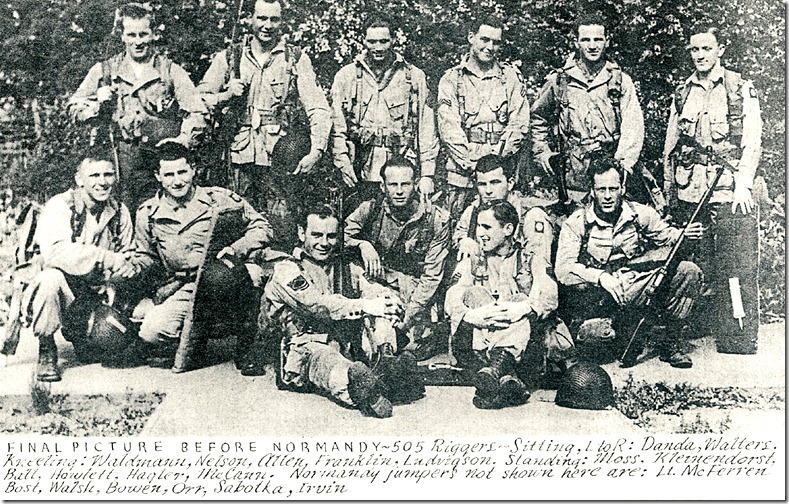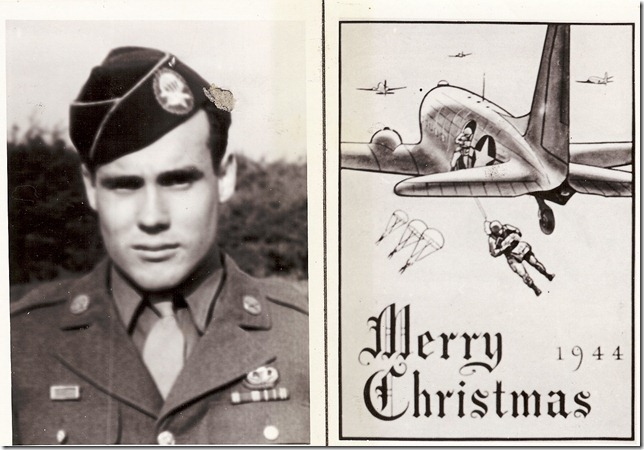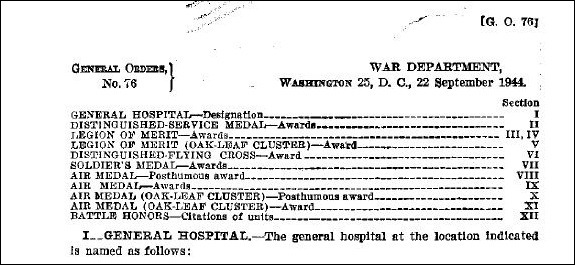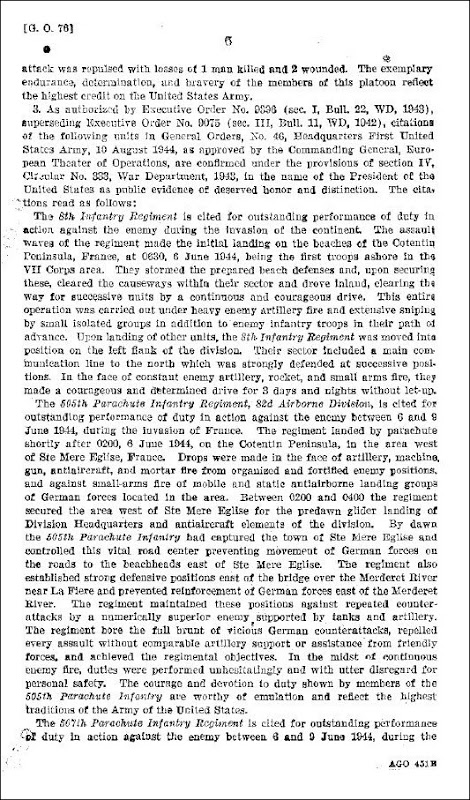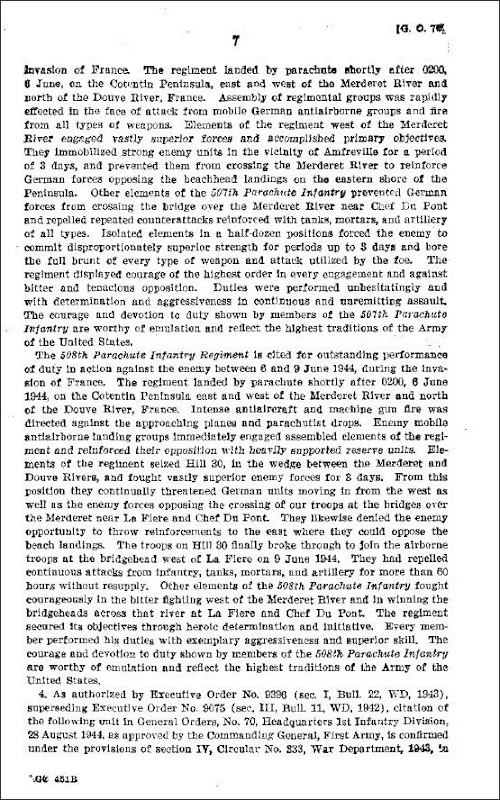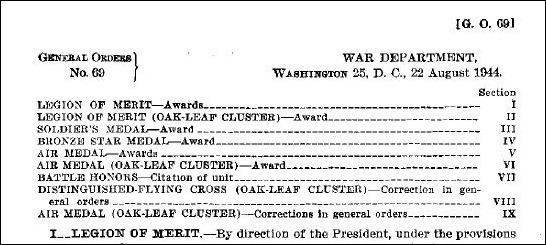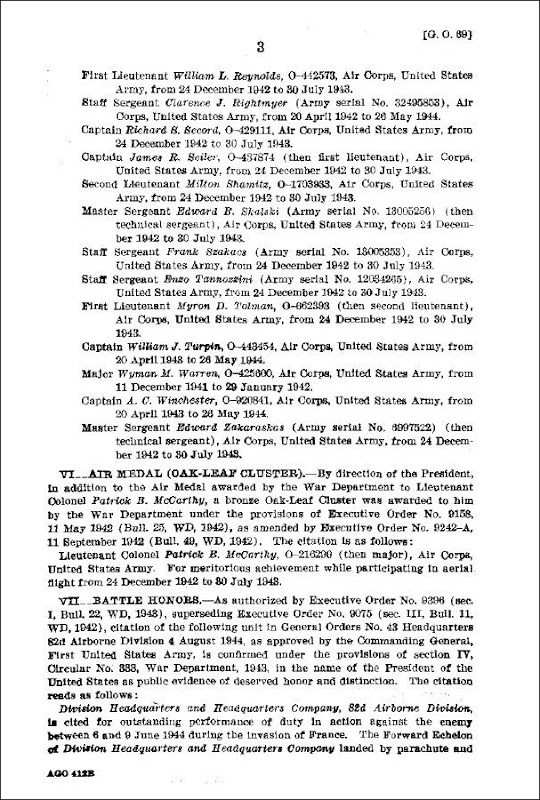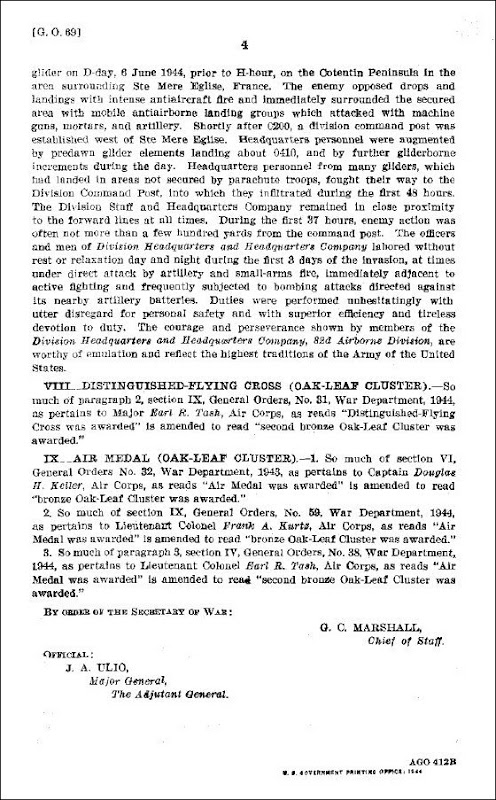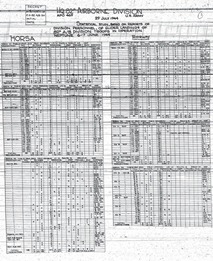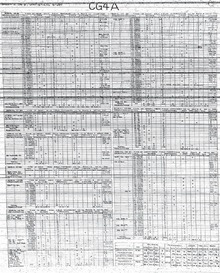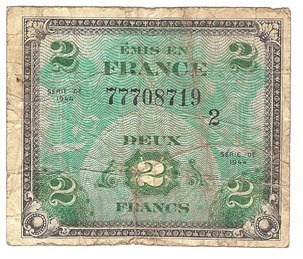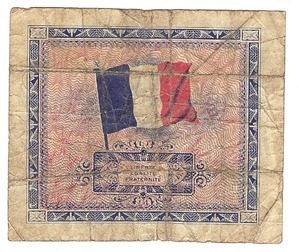The question of whether Bill was in Normandy has already been answered conclusively by the previous post concerning Part 1 of this series on Normandy. Let’s turn our attention now to the mystery surrounding his participation in that historic campaign by shedding some light on the questions asked at the beginning of that post:
- Was Bill selected to jump as a 505 PIR combat rigger?
- Which unit was he assigned to for the Normandy invasion?
- What was his mission in Normandy?
- Did he arrive in Normandy via parachute or glider and on what date?
In the process we’ll learn a lot about the history of the 82nd Airborne Division combat parachute riggers in WWII. Their story is part of the Division’s heritage and it’s one that’s all but lost. Outside of a few dusty manuscripts and reports housed in the nearly inaccessible vaults of museum archives, the story of these paratroopers remains largely unknown to interested parties. Hopefully, this blog entry and the next will do the topic some justice by documenting the structure and function of 82nd Airborne combat rigger units and the onerous yet vital tasks the paratroopers assigned to them had to perform.
Question 1: Was Bill selected to jump as a 505 PIR combat rigger?
Mission, Organization, and Tasks of the Combat Riggers in the 82nd Airborne Parachute Maintenance Company in WWII
Ever since the unit’s formation in 1942 and until March 1, 1945, the company’s designation was the 82nd Parachute Maintenance Company (PMC) (Provisional). In a technical sense, the men working in this unit remained assigned to their respective parent companies or battalions. In particular, the riggers of Service Company 505 PIR and 504 PIR; the riggers of the 456 and 376 Parachute Field Artillery Battalions; and those of the 307 Parachute Engineers Battalion were technically assigned to their parent units the 82nd Airborne Division. For the Normandy Campaign the riggers of Service Company 507 PIR and 508 PIR also remained technically assigned to their respective regiments. In all cases these men were assigned to Special Duty with the 82nd PMC (Provisional) until relieved to be reassigned to their parent companies or other units as the need arose. Source: Author Unknown, “82nd Airborne Division: 82nd Parachute Maintenance Company” Section 1 Unit History, p. 9. Date unknown.
Being technically assigned to their parent units, carried practical implications for the riggers. For the purposes of payroll, Bill and the other 505 riggers are listed as being assigned to Service Company 505th PIR for the period June, July, August and September, 1943, despite the fact that various times during this period, these men were assigned Special Duty to the 82nd PMC (Provisional) performing parachute packing and maintenance. Mail was handled in the same way. Bill sent letters home in 1943 and 1944 with the return address being Service Company 505th PIR regardless of whether or not he was assigned to Special Duty in the PMC (Provisional). In the case of citations related to individual merit on the battlefield, these men were again assigned their awards based on their technical (parent) company designation, regardless of which combat company they were assigned to for an invasion. This was the case for Bill’s Combat Infantryman Badge citation which states that he is assigned to the 505th PIR Service Company.
Mission of the 82nd PMC (Provisional)
The company’s mission was to maintain, repair, pack, safeguard, inspect, issue, and recover used parachutes. They were also tasked with the design and manufacture of specialized parachute equipment bundles for a variety of combat and field operation necessities. Already as onerous a mission as anyone would have liked, these riggers were further required to be trained combat paratroopers, and as such, they regularly participated in combat training exercises including, battlefield tactics, weapons training, close quarters combat, and practice jumps. Incidentally, by the end of his service, Bill had racked up 52 combat condition jumps. Source: Author Unknown,“82nd Parachute Maintenance Company: Letter to Office Division Parachute Officer” April 23, 1949, pp. 1-2 April 23, 1949
Organization and Tasks of the 82nd PMC (Provisional)
The company was composed of five platoons each tasked with specific functions to perform. There were two “Packing Platoons”. As the term suggests they were responsible for the inspection and packing of parachutes, but they had additional duties. Before a man boarded a plane for a jump he was inspected by a paratrooper from a Packing Platoon to ensure his equipment was functional and was fitted correctly. At the training drop zones used in preparation for a combat operation, members of the Packing Platoons recovered used parachutes and equipment bundles. During actual combat operations riggers chosen from all of the PMC (Provisional) platoons were selected to jump with the combat units to recover equipment from the drop zones, primarily to clear the way for gliders and airplanes and also to quickly recover parachutes to prevent their damage.
The third platoon was termed the “Maintenance Platoon”. When a member of a Packing Platoon found a defect in a parachute or equipment bundle either during an inspection or after recovery, it was transferred to the Maintenance Platoon for inspection to determine if it could be repaired locally or needed to be forwarded to a parachute depot for more extensive repair. The Maintenance Platoon used light and heavy sewing machines and other machinery to effect parachute repairs. This platoon was also responsible for the design and manufacture of the equipment bundles to address the needs peculiar to airborne combat teams.
The forth platoon was called the “Air Force Supply Platoon”. Once a parachute or equipment bundle was packed and successfully inspected by a Packing Platoon, it was stored by the Air Force Supply Platoon which issued it for use when requested. They maintained the records of the receipt and issue of parachutes and equipment bundles. While in storage they made periodic inspections of the Division’s inventory. They were responsible for the safekeeping of all this equipment which was no small thing as its value was USD $8,000,000 in 1944 or USD $105,530,000 in 2013 according to the currency calculator at the US Bureau of Labor and Statistics (BLS) found here: http://data.bls.gov/cgi-bin/cpicalc.pl
A “Headquarters Platoon” made up the final and the fifth platoon. They were tasked with all of the administrative work for the PMC (Provisional) so that the other platoons could fully concentrate on their own separate tasks. They ran the company mess, motor pool, supply and personnel sections and were responsible for scheduling combat and jump training for the riggers of the other platoons. The men of Headquarters Platoon were combat riggers in their own right which meant they were trained in all tasks of rigging and combat so that at a moment’s notice they could work as a member of any of the other platoons when required. Source: Author Unknown,“82nd Parachute Maintenance Company: Letter to Office Division Parachute Officer” April 23, 1949, pp. 1-2 April 23, 1949
On the question of which platoon Bill was assigned to, there is evidence that he (and most likely all riggers in the 82nd PMC (Provisional) ) was trained to perform the tasks of all four operational platoons. There is no evidence that Bill was ever assigned to the Headquarters Platoon. From Bill’s Separation Papers it’s clear he inspected parachutes and packed them, and used sewing machines. He told stories of working in a team of two to inspect parachutes on 12’ X 12’ tables indicating that he was at times assigned to a Packing Platoon. In other stories he told of using sewing machines to make special equipment packs which indicates he had variously been assigned to the Maintenance Platoon. In a later post, I will relate a story he told involving the record keeping of packed parachutes indicating he was assigned to the Air Force Supply Platoon on at least one occasion.
Changes in the Organization of the 82nd Airborne Riggers After the Normandy and Rhineland Campaigns
On October 26, 1944 the 82nd PMC (Provisional) received a letter from 82nd Airborne Division Headquarters which ordered a change to the unit designations of its men. Instead of Service Company 505th PIR, Bill and the rest of the 505 riggers were now designated Detachment No. 1 Service Company 505th PIR. Riggers from the former 504th PIR and 508th PIR were similarly designated respectively as: Detachment No. 1 Service Company 504th PIR; and Detachment No. 1 Service Company 508th PIR. The 507th* PIR had been earlier detached from the 82nd so it wasn’t affected by this change. Source: Author Unknown, “82nd Airborne Division: 82nd Parachute Maintenance Company” Section 1 Unit History, p. 12. Date unknown.
There were also riggers from other companies in the 82nd Airborne, specifically: the 456 and 376 Parachute Field Artillery Battalions, and the 307 Parachute Engineers Battalion. These men were now assigned to Detachment No. 1 Service Company 504th PIR. Source: Author Unknown, “82nd Airborne Division: 82nd Parachute Maintenance Company” Section 1 Unit History, p. 12. Date unknown.
Despite these changes, the men of the 82nd PMC (Provisional) worked and lived as they did before the change in unit designation. Source: Author Unknown, “82nd Airborne Division: 82nd Parachute Maintenance Company” Section 1 Unit History, p. 12. Date unknown.
I am aware of two letters Bill wrote home during this time including one dated December 15, 1944 and another January 14, 1945. Both used the return address of Detachment No. 1 Service Company 505th PIR. Prior letters Bill sent used the previous designation of “Service Company 505th PIR”.
On March 1, 1945 82nd Airborne Division Headquarters issued General Order No. 25 which contained instructions to drop the “Provisional”. The 82nd Airborne Parachute Maintenance Company officially became a parent unit within the 82nd Airborne Division entirely composed of riggers from Detachments No 1. 504 and No 1. 505. Detachment No 1. 508th* PIR was not included in the reorganization. As the 82nd PMC (Provisional) did before it, the new unit reported directly to 82nd Division Headquarters. Source: Author Unknown, “82nd Airborne Division: 82nd Parachute Maintenance Company” Section 1 Unit History, p. 12. Date unknown.
From March 1, 1945, the riggers from the 504 and 505 PIRs were permanently reassigned to the 82nd PMC. From that date they sent mail with the return address of 82nd Parachute Maintenance Company, as Bill did in his letter home dated June 13, 1945. After March 1, 1945 any medals earned or unit citations awarded to the men of this new unit would list the recipients as being assigned to the 82nd PMC. These men were no longer members of their old parent regimental companies. The change came as a disappointment to Bill who through and through was the embodiment of a 505 trooper.
507th* The 507th PIR had been detached from the 82nd Airborne after the Normandy campaign and reassigned to the 17th Airborne Division.
508th* On April 5, 1945 the 508th PIR was detached from the 82nd Airborne Division.
The 82nd PMC (Provisional) in Preparation for the Normandy Campaign
According to the history of the 82nd PMC, from mid-February 1944, the riggers from the 505th PIR, 507th PIR, and 508th PIR, worked together as a unified team at Camp Ashwell on Cottesmore airfield, near Oakham England. Coordination of the individual regimental rigger units was necessary to achieve the massive output required for training before and use during the upcoming Normandy invasion. Source: Author Unknown, “82nd Airborne Division: 82nd Parachute Maintenance Company” Section 1 Unit History, p. 9. Date unknown
“By this time [late April, 1944] the regiments and battalions were making training jumps, so practically all of the chutes on hand were used. The packers really had to push the quantity out again in preparation for another operation. This time the men were preparing for the famed D-Day jump.”
“[Using sewing machines] They were turning out special equipment for an entire division…on a production line scale. The bulk of this work consisted of 5,000 ammunition pouches, 1000 red star flags, chute patrol arm bands, medic arm bands, medical aprons, 500 medical kits, 16 blackout tunnels for field hospitals, 300 containers for large radios, 600 for medium radios, 900 for small radios, plus radar slings and packs for the pathfinder groups. They made 800 BAR containers, 800 LMG [Large Machine Gun] containers as well as all the harness [sic.] for mortar carts and wire wheel carts.” Source: Author Unknown, “82nd Airborne Division: 82nd Parachute Maintenance Company” Section 1 Unit History, p. 10. Date unknown
The teams of riggers worked in two 12 hour shifts in a 24 hour operation to achieve these huge industrial sized production requirements. When they weren’t rostered to perform rigging tasks the Headquarters Platoon scheduled riggers to take part in combat and jump training. Bill said that he trained in Sherwood Forest and that the combat exercises consisted of a lot of commando style operations emphasizing close quarter fighting methods, and hand to hand combat techniques to conserve ammunition.
Bill’s official unit designation during this time was “Service Company 505th PIR”. He was assigned to Special Duty with the 82nd PMC (Provisional) in one of the Packing, Maintenance, or Air Force Supply platoons of the 505 PIR rigger section and continued working alongside the other 82nd rigger units in the sheds provided to them at Camp Ashwell. On April 22, 1944 the 504 PIR riggers arrived from Italy and joined them.
Previously, in North Africa in 1943, there were 65 505th* riggers and 75 in the 504th* assigned on Special Duty to the 82nd PMC (Provisional). At camp Ashwell as of April 20, 1944, the collective number of riggers swelled to approximately 320 and included those from the 505th, 507th, 508th, and some from the 456th Parachute Field Artillery Battalion. Source: Author Unknown, “82nd Airborne Division: 82nd Parachute Maintenance Company” Section 1 Unit History, p. 3 & 9. Date unknown.
505th* While based in Oujda, Morocco, men from the first men of the 456th Parachute Field Artillery Battalion were assigned to work with the 505th riggers. Ten men from EGB 446 and 447 (AKA Excess Government Baggage – essentially men in reserve battalions, awaiting reassignment to a regular regimental company) were assigned to the 504th and 505th rigger sections. Bill was one of these 10 men; in his case assigned to the 505th PIR Service Company as detailed in this prior blog post: http://ww2tribute.blogspot.com/2010/07/assignment-to-505th-parachute-infantry.html.
504th* This number, presumably included the riggers from the 376 Parachute Field Artillery Battalions, and the 307 Parachute Engineers Battalion which had been part of the 82nd PMC (Provisional) since 1942 Source: Author Unknown, “82nd Airborne Division: 82nd Parachute Maintenance Company” Section 1 Unit History, p. 2. Date unknown.
Assignment of 82nd Airborne Riggers to Combat Companies During the Normandy Campaign
As had been done in Sicily and Salerno, some of the riggers were to be selected to jump into Normandy with combat companies from their respective parent regiments.
In general the mission of riggers selected to jump into combat were two fold:
- To instill confidence among the troopers that the parachutes were free of defects and had been packed correctly.
- To retrieve used parachutes quickly (as soon as enemy fire permitted), while they were still salvageable, and in the process clear the way for gliders and aircraft to land on the drop zones.
Upon being selected for the jump, riggers were required to train with their assigned combat companies focusing on the objectives of that unit. Once on the ground in the combat zone, these riggers would fight as infantry men on the front line in until the battle objectives of their units were achieved and the area secure. Afterward, they would take on the task of recovering parachutes and equipment for later repair; and to clear the drop zone for gliders and aircraft to land. Source: , “82nd Parachute Maintenance Company: Letter to Office Division Parachute Officer” April 23, 1949, p. 1.
Typically,when a 505 rigger was selected for a combat jump, he would be relieved from Special Duty in the 82nd PMC (Provisional) and then assigned to the 505 Service Company. Later he would be assigned to duty in one of the 505 PIR combat companies to train on the unit’s specific objectives and when the time came he would make the jump with that company. Source: Author Unknown, “82nd Airborne Division: 82nd Parachute Maintenance Company” Section 1 Unit History, p. 4. Date unknown.
According to the history of the 82nd PMC, there were 21 riggers (20 enlisted men and one officer, Lt. McFerren) selected from the 505 rigger section of the 82nd PMC (Provisional) who were assigned to the 505 Service Company and subsequently assigned to separate combat companies for the Normandy jump. Source: Author Unknown, “82nd Airborne Division: 82nd Parachute Maintenance Company” Section 1 Unit History, p. 10. Date unknown.
All but one of the 505 riggers selected to jump into Normandy are photographed and/or named in Photo 7 below.
Photo 7: The 505 Riggers Selected to Jump with the 505th Parachute Infantry Regiment into Normandy
Source: National Archives
William Clark is not listed as a name on the annotation and he does not appear in the photograph of the 505 riggers before the Normandy jump. There are only 19 enlisted men listed in the photo’s annotation. There are 20 men listed in the annotation counting Lt. McFerren. But there should be 20 enlisted men and one officer.
The History of the 82nd PMC states:
“About 65 of the men in camp jumped into Normandy on D-Day…The 505 was a typical combat team as they jumped two riggers to a company totaling 20 riggers and 1 officer.” Source: Author Unknown, “82nd Airborne Division: 82nd Parachute Maintenance Company” Section 1 Unit History, p. 10. Date unknown.
According to this one enlisted man, the 2oth, is missing from the photo’s annotation. It is possible that Bill is the one man not listed in Photo 7.
As we have seen in the first post on Normandy, the evidence is incontrovertible that Bill in fact fought there. Despite the discrepancy in Photo 7, the fact that he was present in Normandy demonstrates that he did not necessarily need to follow the established route a rigger takes to make the team assigned to the combat jump. That is, he did not necessarily need to be transferred out of the 82nd PMC (Provisional), into Service Company 505, and then into a 505 combat company in order to make the jump or even glider mission into Normandy.
Unless Bill is the missing man in Photo 7’s annotation, all the evidence points to his transfer to a different unit of the 505, possibly at short notice (or even a unit outside of the 505), thereby not making the regimental rigger team in Photo 7.
If he wasn’t with the official team of 505 riggers jumping into Normandy, then this was not the first time Bill found a way to make his way into a jump. In Salerno he volunteered and somehow was chosen to jump in a 504th PIR serial. As we have seen and will see in future posts, Bill developed an affinity for volunteering during his time in the service. For instance, he volunteered to go on patrols during the Battle of the Bulge. Later he placed his name on a list in the hopes of being selected for occupation duty in Berlin, Germany and subsequently was assigned there.
Other Possibilities Explaining Bill’s Unit Assignment
One possibility is that Bill replaced a man who was sick or was injured before D-Day. The History of the 82nd PMC makes mention of one man, Herbert Ott, who was relieved from Special Duty in the 82nd PMC (Provisional), assigned to Service Company 505 and was selected to make the jump into Normandy.
“As the men were loading the planes for the fateful morning of 6 June 1944, Ott of the 505 was wounded by a land mine exploding.” Source: Author Unknown, “82nd Airborne Division: 82nd Parachute Maintenance Company” Section 1 Unit History, p. 10. Date unknown.
According to a Letter to the Division Parachute Officer dated April 23, 1949 detailing the duties of the 82nd PMC and how it functioned and was composed in WWII:
“Before any parachutist boards a plane for a jump he is inspected by a member from the packing platoons to insure that his equipment is in good shape and properly fitted. Again at the drop zones, members of the packing platoons are present to safeguard and aid in the recovery of Air Force equipment.” Source: , “82nd Parachute Maintenance Company: Letter to Office Division Parachute Officer” April 23, 1949, p. 1.
Because we know Bill jumped in Sicily and Salerno, and packed parachutes, it is quite possible he was assigned to a parachute packing platoon in the 82nd PMC (Provisional) at the time before the Normandy jump. If he was not otherwise selected for the jump, this would make it possible for him to be present while the paratroopers were boarding their C-47s on June 5, 1944. It is conceivable that he volunteered to replace an frightened, sick, (or injured trooper such as Ott), before they took off and was given permission to jump at short notice.
Indeed, there are cases of men who otherwise would have missed the jump finding ways to make it. In the case of the explosion involving Ott, his C-47 was damaged and it couldn’t take off. All those onboard were injured except one man who was able to find a seat on board another aircraft. Source: “All American All the Way: The Combat History of the 82nd Airborne Division in World War II, Phil Nordyke, 2005, p. 199.
There was a lot of latitude given to troopers in making their own decisions to participate in combat jumps even when they were convalescing from injuries. In one case, a man with a broken hand was given the choice of jumping into Normandy or staying behind. Despite his broken hand being in a bandage, he decided to do it and successfully made the jump. Source: “All American All the Way: The Combat History of the 82nd Airborne Division in World War II, Phil Nordyke, 2005, p. 197.
Even if copies of other records such as morning reports, (which were burned in the 1973 fire at the National Archives Personnel Records Center in St. Louis, Missouri) do exist and suggest that he may not have jumped; it is evident there were several avenues for Bill to volunteer to make the jump into Normandy and have it approved at very short notice without documentation.
As mentioned above, evidence abounds that Bill had a proclivity for volunteering for duty at short notice and that he had a track record for finding ways to make jumps. It was a major blow to those riggers who were left behind in England during the Normandy invasion. We will see in the next blog post that by the time Normandy came around, Bill was widely recognized as an “Old Man” who knew the system very well and was adept at working it to his advantage. If he wasn’t selected as one of the 2o riggers making the Normandy jump for the 505 PIR, he would have done everything in his power to make it there by whatever means possible.
From photographic evidence and his service record, we already know that Bill was in Normandy. So even if records such as morning reports turn up in future and do not support his transfer from Special Duty 82nd PMC (Provisional) to Service Company 505, and then to a 505 combat company, it is abundantly clear he found another way to get into Normandy either via parachute or possibly even a glider.
Question 2: Which unit was Bill assigned to for the Normandy invasion?
Photographic Evidence Pertaining to Bill’s Unit Assignment During Normandy
Bill sent a letter home in 1944 which included a picture. The exact date of the letter is unknown. However the picture was affixed to a Christmas card issued by the 82nd Airborne for use in connection with Christmas 1944. See Photo 8 below.
The previous year, Bill sent a Christmas card home post marked November 1, 1943 (55 days before Christmas). It could take around six weeks for mail to be delivered at the time, so in all likelihood he sent the 1944 Christmas card home at about the same time of year, at approximately November 1, 1944. What is interesting is that in the picture he is wearing a Presidential Unit Citation (PUC) badge on his right breast. At the time the PUC was called the Distinguished Unit Citation. The name changed from DUC to PUC on November 3, 1966. His Honorable Discharge records a distinguished unit badge which means he was assigned to a unit when it received the PUC.
Photo 8: Picture of Bill Clark most likely taken after September 22, 1944 which he included in a Christmas Card sent home to his family. The photograph clearly shows the Presidential Unit Citation badge displayed on his right breast.
Photo 8 does not have Bill’s Bronze Service Stars pinned onto his EAME ribbon. Bill was notorious for not always wearing all of his medals. According to his brother Henry, the second occasion that Bill visited him in Heston airdrome outside London, he wore only his EAME campaign ribbon and didn’t wear any Bronze Service Stars at all. Bill is wearing his efficiency award ribbon in Photo 8 above, but it does not appear in Photo 1 of 1945 shown in the previous blog post, which was shot approximately eight months later.
Photo 8 is evidence that he was assigned to a unit which received the PUC during Normandy. Prior to Normandy the only 82nd Airborne units to receive the PUC were:
- 319th Glider Field Artillery Battalion
- Company H, 504th Parachute Infantry Regiment
- Headquarters Battery, 80th Airborne Antiaircraft Battalion
- Battery D,E,F, 80th Airborne Antiaircraft Battalion; and
- Medical Detachment, 80th Airborne Antiaircraft Battalion.
These units were awarded the PUC for their roles as part of the Ranger force which seized and held the Chiunzi Pass during the Naples-Foggia Campaign in September of 1943. (See the previous posts regarding Salerno and the liberation of Naples). Bill was not assigned to any of these units while he was in Italy, nor at any time in 1944, so he couldn’t be wearing the PUC awarded to these units.
Determining which units received the PUC in Normandy and when they received it might help narrow down the unit he was most likely assigned for that campaign. The 82nd Airborne units which received the PUC for Normandy were:
- 82nd Airborne Division Headquarters and Headquarters Company
- 325th Glider Infantry
- 505th PIR
- 507th PIR (attached to the 82nd Airborne for the Normandy Campaign)
- 508th PIR (attached to the 82nd Airborne for the Normandy Campaign)
- Headquarters and Headquarters Battery, 82nd Airborne Division Artillery
- 319th Glider Field Artillery Battalion
- 320th Glider Field Artillery Battalion
- 82nd Airborne Signal Company
- 307th Airborne Medical Company
- Headquarters and Batteries A, B, and C 80th Airborne Antiaircraft Battalion
- Companies A and B, 307th Airborne Engineer Battalion
Source: “I’m the 82nd Airborne Division” Anzuoni, P. 2005 p. 355
The procedure for issuing a PUC to a unit in WWII was as follows. The unit was cited for the PUC in General Orders of the Division Headquarters or the Army Group to which it was assigned. These were then forwarded to the Commanding General of the Theater of Operations for approval or disapproval. If approved the recommendation was forwarded to the Secretary of War for assessment. If approved at that level, the award was authorized in a General Order issued by the War Department and signed by the Secretary of War. It was only after the award was authorized by the Secretary of War that the unit was actually awarded the PUC and badges physically issued to individual soldiers.
To narrow down Bill’s possible unit assignments in Normandy it is reasonable to assume he would have been assigned to a parachute infantry regiment. For the three parachute regiments of the 82nd Division and the 82nd Division HQ & HQ Company, which took part in the Normandy invasion, the dates of initial division level citation of the PUCs, their dates of final approval/authorization of award by the Secretary of War, and War Department General Order numbers are:
| Unit | Div. General Order Citation Date | Secretary of War Award Date | War Dept. General Order Number |
| 82nd Division HQ & HQ Co. | 4 August 1944 | 22 August 1944 | GO 69 WD 44 |
| 505th PIR | 10 August 1944 | 22 September 1944 | GO 76 WD 44 |
| 507th PIR | 10 August 1944 | 22 September 1944 | GO 76 WD 44 |
| 508th PIR | 10 August 1944 | 22 September 1944 | GO 76 WD 44 |
Source: “Maneuver Center of Excellence Libraries Donovan Research Library US Armor Research Library Historical General Orders/Special Orders Collection: General Orders 1942- 1945” Retrieved from http://www.benning.army.mil/library/content/Virtual/General%20Orders/GeneralOrders/GO%201942-1944.pdf (WARNING: Very large file. Opening it in you browser will take a long time and possibly cause a crash. RIGHT CLICK your MOUSE to SAVE it. Then open the file once downloaded.)
Note: Read the post Meaning of GO 33 WD 45 on a WWII Veteran’s Discharge for more information on other War Department General Orders including PUC text, the text of other unit citations, Meritorious Service Awards, the names of Bronze and Silver Star recipients in WWII, as well as dates, and geographical limitations of Bronze Service Star qualifying campaigns in WWII.
Bill’s Assignment to 82nd Airborne Division HQ Company or the 505, 507, or 508 PIR
According to the testimonies of Bill and his brother Henry documented in the first post on Normandy, Bill fought with the 505 PIR in St. Mere Eglise in Normandy. Photo 8 of Bill wearing the PUC badge on his uniform before Christmas 1944 and the preceding analysis of units awarded the PUC tells us that he was assigned to a unit which received the PUC award for the Normandy Campaign. The PUC for the 505th PIR, was awarded on 22nd September 1944 which means that Photo 8 must have been taken after that date. (See Note 1 containing the citation text below).
Almost certainly Bill received the PUC badge for being assigned to the 505 during June 6 – 9, 1944. While it is plausible that Bill could have been assigned to an 82nd Airborne parachute regiment other than the 505th, it is unlikely. However, due to the mis-dropped serials of paratroopers from the 508th and 507th PIRs, it is conceivable that he was assigned to one of them and wound up in St. Mere Eglise on June 6th. This is a remote likelihood, but for the sake of exhausting all credible possibilities it needs to be at least mentioned as a candidate.
Besides the 507th or 508th PIR, (See Note 1 below for the PUC texts), Bill’s other possible assignment is to the 82nd Division Headquarters Company (See Note 2 below for this PUC text).
Note 1: 82nd Airborne 505th , 507th, and 508th PUC for Normandy was awarded on September, 22 1944
Source: “Maneuver Center of Excellence Libraries Donovan Research Library US Armor Research Library Historical General Orders/Special Orders Collection: General Orders 1942- 1945” Retrieved from http://www.benning.army.mil/library/content/Virtual/General%20Orders/GeneralOrders/GO%201942-1944.pdf
Note 2: 82nd Airborne Division Headquarters & Headquarters Company PUC for Normandy was awarded on August 22, 1944
Source: “Maneuver Center of Excellence Libraries Donovan Research Library US Armor Research Library Historical General Orders/Special Orders Collection: General Orders 1942- 1945” Retrieved from http://www.benning.army.mil/library/content/Virtual/General%20Orders/GeneralOrders/GO%201942-1944.pdf
There is further evidence that Bill was assigned to one of the four units during the time they received their PUCs for Normandy and not assigned to it subsequently.
As per Note 3 below, if he was assigned to the unit at a time after the events happened he would only be allowed to wear the Distinguished Unit Badge while he was assigned to the unit. Once he was reassigned to a different unit, he would not be eligible to wear it.
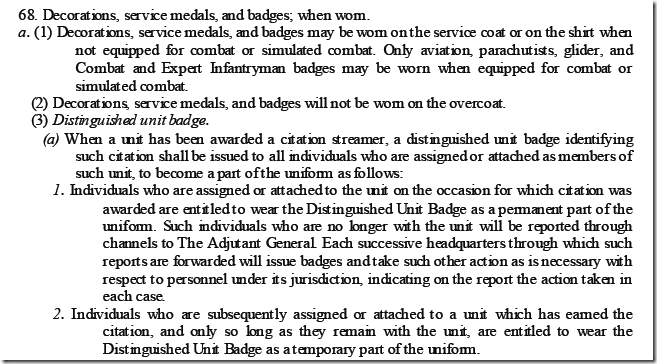 Note 3: Excerpt of Army Regulations No. 600-40 War Department 31 March 1944 paragraph 68
Note 3: Excerpt of Army Regulations No. 600-40 War Department 31 March 1944 paragraph 68
Bill has the Distinguished Unit Badge (or PUC) on his his service record. In Photo 8 he is wearing the citation badge associated with it. In Photo 1 taken after May 11, 1945 he is wearing the citation badge even though he was assigned to the 82nd PMC at that time; a unit which never received the award.
According to Paragraph 68-3 of Army Regulations No. 600-40 War Department 31 March 1944, these facts mean it was not a temporary decoration. When Photo 1 was taken Bill was not part of the unit which received the PUC. As of March 1, 1945 Bill was reassigned from Detachment 1 Ser Co 505 PIR to the 82nd PMC, so the only way he could still wear the PUC for Normandy is if he was assigned to the awarded unit on the dates that unit was cited.
In other words, Bill must have been assigned to the 82nd Division Headquarters Company, the 505th PIR, the 507th PIR or the 508th PIR during the dates of 6 – 9 June 1944, with the 505th PIR being the most certain one.
Question 3: What was Bill’s mission in Normandy?
Given Bill’s rigging background and skills, his primary mission in the Normandy invasion most likely was parachute and equipment recovery.
If Bill was not a member of the official 505 PIR rigger team jumping into Normandy, one important clue to the mystery of his exact mission may come from the pre-Normandy movements of his commanding officer, Captain Albert G. Marin the commander of the 82nd PMC (Provisional) from November 1st, 1943 until June 1, 1944. source: I’m the 82nd Airborne Division Anzuoni, P. 2005 pp. 363
Interestingly, according to the Unit History of the 82nd PMC a few days before the Normandy jump Captain Marin was relieved from duty with the 82nd PMC (Provisional) and reassigned to 82nd Division Headquarters. He was promoted to Major on June 1, 1944. During the Normandy invasion his new duties required his close contact with the 82nd PMC (Provisional). Source: Author Unknown, “82nd Airborne Division: 82nd Parachute Maintenance Company” Section 1 Unit History, p. 10. Date unknown.
Did Bill somehow follow Major Marin in an associated capacity out of the 82nd PMC (Provisional) and into one of the 82nd Division units invading Normandy? Did Major Marin or other commander recommend him and possibly other men to the 82nd Airborne Division G-4 for the Normandy jump (the newly promoted Lt. Col. Bennie A. Zinn), resulting in a late and possibly not documented transfer from the 82nd PMC (Provisional) and into the 82nd Division Headquarters Company, the 505th PIR (and/or the 507th or 508th) to help in the recovery efforts? Did he and other riggers jump and/or glide in with these units to help recover parachutes and equipment initially dropped as well as to recover additional supplies dropped in the early days of the invasion?
It is well known that the parachute equipment recovery efforts were badly hampered by the local conditions in Normandy. The recovery of equipment proved to be extremely difficult, due to the fields being purposely flooded by the Germans. The men of the 82nd had enormous problems in retrieving bundles delivered by parachute which contained bazookas, mines, radios and other vital equipment from the swamp land. Source: Gavin, J. “On to Berlin: Battles of an Airborne Commander 1943 - 1946” 1978 pp. 105 – 107.
Moreover some of these bundles had landed hidden and unseen behind hedgerows, and some had fallen into German hands.
Another account of recovery difficulties states:
“Glider-borne anti-tank six-pound guns and considerable equipment were lost as widely scattered gliders were wreaked or came under fire. This was the pay-off of hectic, rushed planning.” Source: List of Important Battles pp. 43-44 “Maneuver Center of Excellence Libraries Donovan Research Library US Armor Research Library Historical Microfilm Documents Collection “D78 Item nos. 2000-2019 - United States Army 82nd Airborne Division narratives from operations in Sicily, Italy, Normandy, Holland, Ardennes, and Central Europe, August 1942-May 1945” Retrieved from http://www.benning.army.mil/library/content/Virtual/Documents/Microfilm/index.htm which can be found at http://www.benning.army.mil/library/content/Virtual/virtual.htm Direct link to the PDF file: http://www.benning.army.mil/library/content/Virtual/Documents/Microfilm/film/D1-D630/D78_I2000-2019.pdf pp. 43 – 44
Given these losses and recovery difficulties which were apparently caused in part by “rushed planning”, and compounded by the harsh terrain, it is plausible that Bill would be chosen as part of a late transfer of rigger personnel from their maintenance duties to active combat duty at about the same time that their commander, Albert Marin, was transferred to Division Headquarters with orders to work closely with the 82nd PMC (Provisional).
In the few days leading up to the invasion, concern grew over the inadequacy of the planned equipment recovery measures. This in turn could have led to an effort to augment the plan with additional personnel from the 82nd PMC (Provisional) tasked with recovering lost and all but inaccessible equipment bundles.
With two combat jumps under his belt at the time of the Normandy Invasion, Bill was inarguably one of the most experienced riggers in the 82nd Airborne Division. He was just the type of man the newly promoted Major Marin would have recommended to Lt. Col. Zinn, (the G-4 for Normandy from June 1, 1944 – June 16 1944) to reinforce the difficult recovery efforts in the early days of the Normandy campaign.
Question 4: Did Bill arrive in Normandy via parachute or glider and on what date?
There would be two ways for additional recovery personnel to arrive in Normandy – via parachute or glider. First, these men would have been relieved from Special Duty in the 82nd PMC (Provisional) and re-assigned to the 82nd Division Headquarters Company, or the 505th , 507th, or 508th PIRs at around the same time Major Marin was transferred to Division Headquarters on June 1, 1944. Those assigned to a parachute regiment would have then made the jump with their outfit in a C-47 serial as part of Mission Boston in Force A in the early hours of June 6 as documented at the French D-Day website:
http://www.6juin1944.com/assaut/aeropus/en_page.php?page=para.
These men would almost certainly have encountered combat before being able to achieve their primary objective – the recovery of chutes and equipment bundles.
Alternatively, if they were assigned to the 82nd Division Headquarters Company, they could have landed in one of the glider serials carrying elements of that unit as part of Mission Detroit in Force B at 4:07 AM on June 6 and (again probably after initial combat) then went to work recovering equipment. Another possibility would be a later glider landing as part of Mission Elmira in Force B at 9:10 AM , 9:20 AM, 11:00 PM, or 11:10 PM on June 6. You can see the tables for these glider serials at http://www.6juin1944.com/assaut/aeropus/en_page.php?page=glide
Below are the Glider tables for Operation Neptune. Equipment recovery troopers could have been squeezed into any number of them.
Glider Table 1 of 2 for the 82nd Airborne in Operation Neptune (Click for higher resolution)
Source: “Maneuver Center of Excellence Libraries Donovan Research Library US Armor Research Library Historical Microfilm Documents Collection “D78 Item nos. 2000-2019 - United States Army 82nd Airborne Division narratives from operations in Sicily, Italy, Normandy, Holland, Ardennes, and Central Europe, August 1942-May 1945” Retrieved from http://www.benning.army.mil/library/content/Virtual/Documents/Microfilm/index.htm
which can be found at http://www.benning.army.mil/library/content/Virtual/virtual.htm
Direct link to the PDF file: http://www.benning.army.mil/library/content/Virtual/Documents/Microfilm/film/D1-D630/D78_I2000-2019.pdf Page 119
Glider Table 2 of 2 for the 82nd Airborne in Operation Neptune (Click for higher resolution)
Source: “Maneuver Center of Excellence Libraries Donovan Research Library US Armor Research Library Historical Microfilm Documents Collection “D78 Item nos. 2000-2019 - United States Army 82nd Airborne Division narratives from operations in Sicily, Italy, Normandy, Holland, Ardennes, and Central Europe, August 1942-May 1945” Retrieved from http://www.benning.army.mil/library/content/Virtual/Documents/Microfilm/index.htm
which can be found at http://www.benning.army.mil/library/content/Virtual/virtual.htm
Direct link to the PDF file: http://www.benning.army.mil/library/content/Virtual/Documents/Microfilm/film/D1-D630/D78_I2000-2019.pdf Page 120
Since we have already established that Bill was present in Normandy and is wearing the PUC while assigned to the 82nd PMC (a unit which did not receive it) means he either jumped in as a member of one of the four PUC units on June 6 at H hour, or landed in a glider on the morning of June 6, or in one of the glider serials later that day.
But Bill’s own testimony concurs with the scenario that he parachuted into Normandy, landed in St. Mere Eglise and fought with the 505. It also is the explanation that best fits the facts documented in his service record, and in photographs, so this is almost certainly what happened. If Bill arrived in a parachute then there are several alternative possibilities to explain how he did it. In the first, he was assigned as a combat rigger in the 505 following the established channels for eventual assignment to a combat company in the 505. In the second, he was given a late jump assignment to the 505 at the time Captain Marin was transferred Division Headquarters around June 1 to reinforce the difficult equipment recovery conditions. In the third possibility, as a member of the 82nd PMC (Provisional) Packing Platoon, while checking the jumpers’ equipment on the airfield itself, he volunteered to jump, and was given permission to do so. In all three possibilities he would have arrived in at St. Mere Eglise on the early morning of June 6 anywhere from 1:51 AM to 2:03 AM. He would have taken off from either Cottesmore airfield in serial 17, or 18 and hit drop zone O at 1:51 AM or 1:57 AM respectively. Or he took off from Spanhoe airfield in serial 19 and landed in drop zone O at 2:03 AM. We know his C-47 did not mis-drop his stick because he said he landed in St. Mere Eglise.
Bill’s Sole Surviving Memento from Normandy
US occupation francs were printed and distributed to the paratroopers jumping into Normandy. When Bill returned from the War he brought some of the currency home and said it was left over “invasion money” he used when he was in Normandy. All that survives from his collection is this 2 Franc note or “Deux Francs” in French. The date “SERIE DE 1944” is clearly visible on the front.
French Invasion Money issued to Bill Clark prior to the Invasion of Normandy. Source: Author’s Collection
© Copyright Jeffrey Clark 2013 All Rights Reserved.

